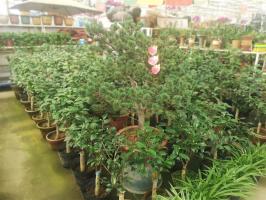What is this Potted Plant?
Houseplants are a beautiful addition to any home, but sometimes it can be difficult to identify the specific type of plant you have. In this article, we will explore how to identify a potted plant and provide some helpful tips on its care and maintenance.
Physical Characteristics of Plants
The first step in identifying a potted plant is to pay attention to its physical characteristics. Take notice of its size, shape, color, and texture. Record these details and use them to research similar plant varieties. Some common potted plant characteristics include:
Size: Is the plant small, medium, or large?
Shape: Is it bushy, tall, or trailing?
Color: Does it have green leaves or leaves of another color? Does it have flowers?
Texture: Are the leaves smooth, rough, or fuzzy?
Researching Plant Varieties
Once you have identified the physical characteristics of your potted plant, use them to research similar plant varieties. There are several resources available online or in books that can help you with this. Look for plant identification guides, gardening forums, or online plant communities. These resources will help you match your plant to its species and learn more about its care requirements.
One helpful tool for plant identification is the plant tag or label that comes with the potted plant. This tag will often provide information about the plant's common name, scientific name, sun requirements, watering needs, and more. Use this information to guide your research and ensure that you are providing the best care for your plant.
Caring for Your Potted Plant
Now that you have identified your plant and learned about its care requirements, it's time to start caring for it. Here are some tips for maintaining a healthy potted plant:
Water: Most plants prefer evenly moist soil. Water your plant when the top inch of soil is dry to the touch. Avoid overwatering, as this can lead to root rot.
Light: Different plants have different light requirements. Read up on your plant's preferred sun exposure and adjust its placement accordingly. If your plant is not getting enough light, it may become leggy or wilted.
Soil: Use a well-draining soil mix for your potted plant. Soil that holds too much moisture can suffocate plant roots.
Fertilizer: Most plants benefit from regular fertilization. Use a balanced fertilizer every 2-4 weeks during the growing season.
Conclusion
Identifying a potted plant may seem challenging at first, but with a little research and attention to detail, you can determine the species and provide appropriate care. By understanding your plant's unique needs, you can enjoy a healthy and thriving houseplant for years to come.

 how many times do yo...
how many times do yo... how many planted tre...
how many planted tre... how many pine trees ...
how many pine trees ... how many pecan trees...
how many pecan trees... how many plants comp...
how many plants comp... how many plants can ...
how many plants can ... how many plants and ...
how many plants and ... how many pepper plan...
how many pepper plan...
































